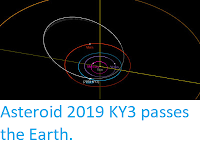Asteroid 2011 TC4 passed by the Earth at a distance of about 12 732 000
km (33.1 times the average distance between the Earth and the Moon, or 8.51% of the distance between the Earth and the Sun), slightly after midnight
GMT on Wednesday 12 June 2019. There was no danger of
the asteroid hitting us, though were it to do so it would have
presented a significant threat. 2011 TC4 has an estimated
equivalent
diameter of 160-520 m (i.e. it is estimated that a spherical object
with
the same volume would be 180-570 m in diameter), and an object of this
size would be predicted to be capable of
passing through the Earth's
atmosphere relatively intact, impacting the ground directly with an
explosion that would be between about 6000 and 470 000 times as
powerful
as the
Hiroshima
bomb. Such an impact would result in an impact crater between 2.5 and 8 km
in
diameter
and devastation on a global scale, as well as climatic effects that
would last decades or even centuries.
The calculated orbit of 2018 XG5. JPL Small Body Database.
2011 TC4 was discovered on 3 October 2011 by the
University of Arizona's Mt. Lemmon Survey at the Steward Observatory on Mount
Lemmon in the Catalina Mountains north of Tucson. The designation 2011 TC1
implies that the asteroid was the 27th object (asteroid C1 -
in numbering asteroids the letters A-Y, excluding I, are assigned
numbers from 1 to 24, with a number added to the end each time the
alphabet is ended, so that A = 1, A1 = 25, A2 = 49, etc., which means that C1 = 3 + (24 X 1) = 27)) discovered in the first half of October 2011 (period 2011 T).
2011 TC4
has an 666 day orbital period and an eccentric orbit
tilted at an angle of 3.13° to the plane of the Solar System, which
takes it from 0.41 AU from the Sun (i.e. 41% of he average distance at
which the Earth orbits the Sun, and slightly outside the orbit of the planet Mercury) to 2.57 AU from the Sun (i.e. 257% of
the
average distance at which the Earth orbits the Sun, and somewhat more
than the orbit of the planet Mars). It is
therefore
classed as an
Apollo Group Asteroid (an asteroid that is on average further from the
Sun than the Earth, but which does get closer). This means that close
encounters between the asteroid and Earth are extremely common, with the
last having occurred in November 2011 and the next predicted
in October 2022. As an asteroid probably larger than 150 m in diameter
that occasionally comes within 0.05 AU of the Earth, 2010 GT7 is also
classified as a Potentially Hazardous Asteroid.
2010 GT7 also
has frequent close encounters with the planets Mercury, which it last came close to in September 2014 and is next predicted to
pass in November 2033, Venus, which it last came close to in June 2001 and is predicted to pass again in December 2033, and Mars, which it last came close to in February 1968
and
is next predicted to pass in October 2193. Asteroids
which make close passes to multiple planets are considered to be in
unstable orbits, and are often eventually knocked out of these orbits by
these encounters, either being knocked onto a new, more stable orbit,
dropped into the Sun, knocked out of the Solar System or occasionally
colliding with a planet.
See also...
Follow Sciency Thoughts on Facebook.







